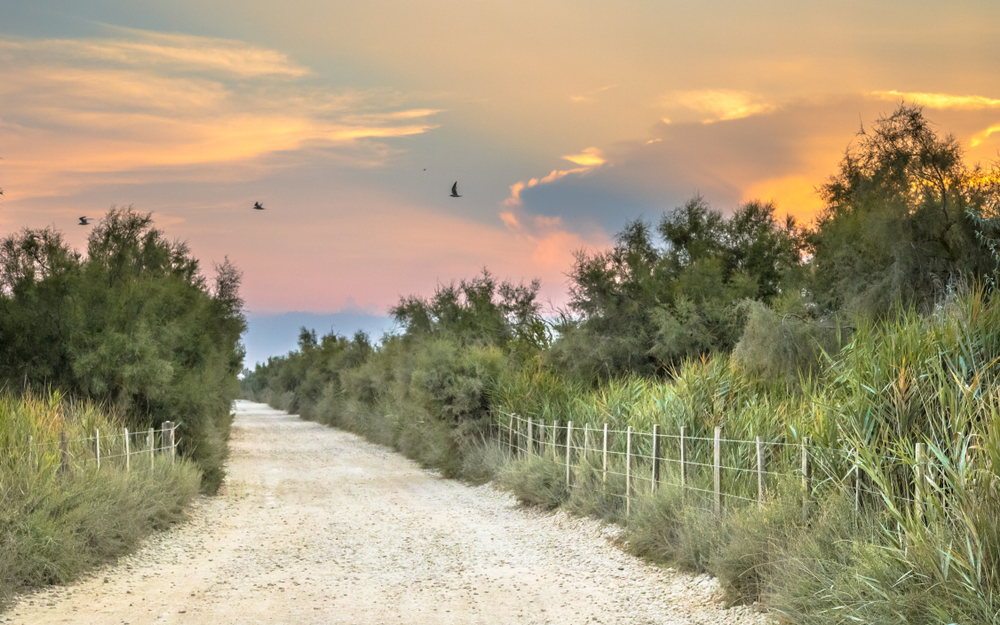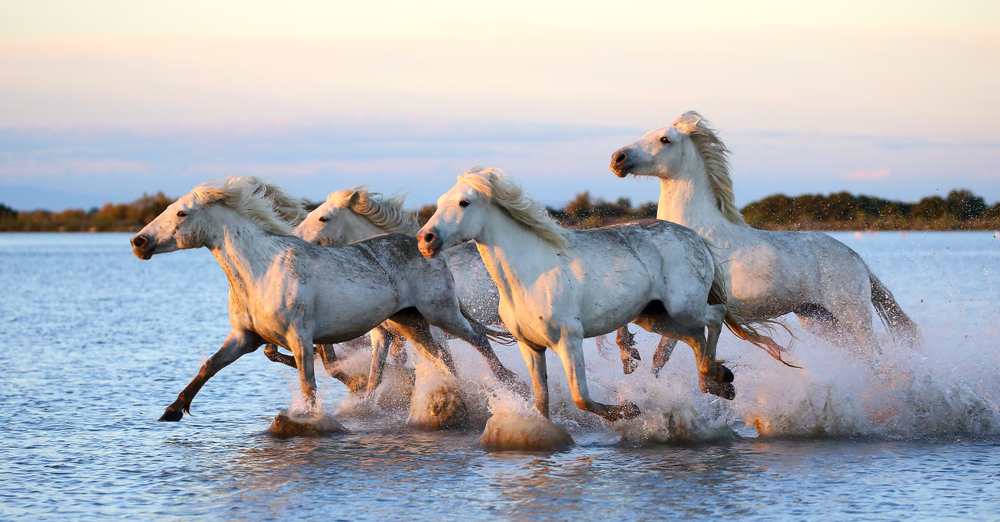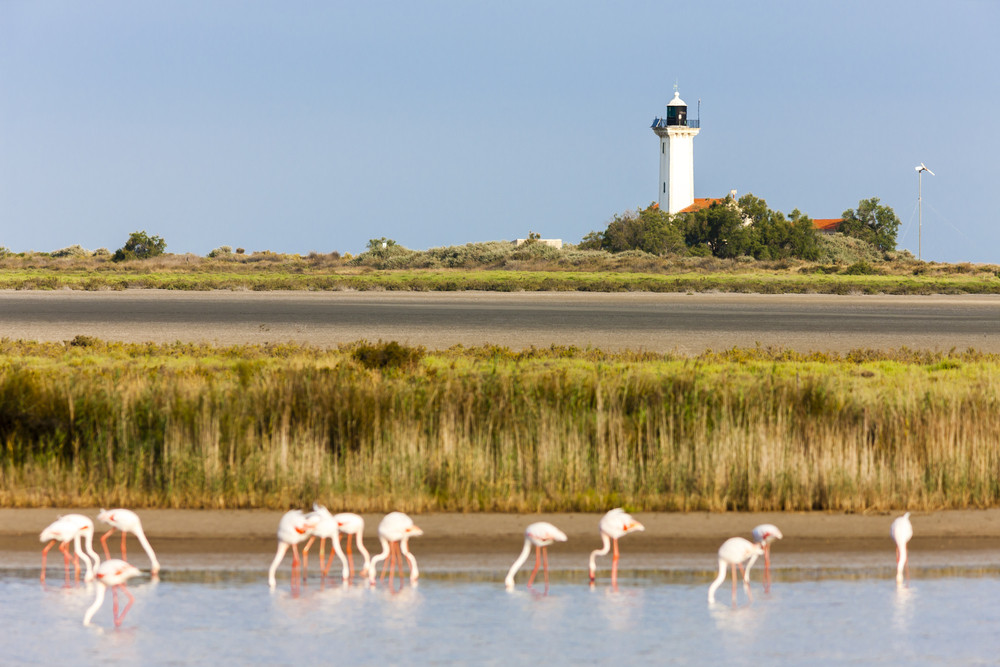Wild horses and wetlands aren’t normally associated with the French Riviera. The Cote d’Azur typically elicits images of designer boutiques and impossibly stylish women in high heels rather than windswept horizons, wildflowers, and pink flamingos. But there it is, just 70 miles west of Marseille (the unofficial end point of arguably the most famous stretch of the western Mediterranean), unfolding into a beautiful, endless landscape.
If you’re eager to get away from the traffic of the coast and hoping to find a quiet place to camp up for the night, this is the place. The scene changes entirely the moment you head west of Marseille. Not many people explore this side of the coast, and perhaps it’s for this very reason that the Camargue Wetlands, an incredible UNESCO-listed reserve, seems to thrive in relative anonymity.
For anyone looking to escape the crowds of the east, or simply discover one of the French Coast’s most hidden of treasures, Camargue is an absolute delight.
The Camargue Wetlands of Southern France: a nature lover’s paradise
The mouth of the Rhône Delta, the largest river delta in western Europe, has been recognised as a natural treasure since the 1920s. It is a haven for over 400 distinct species of migrating birds and is renowned for its white horses, black bulls, and pink flamingos, the latter thriving in just a few select spots on the whole continent. Salt and rice have been harvested here since the Middle Ages, and on the perimeter of marshlands and ponds rest some of the most spectacular Medieval cities in all of France. This is one of the most important and protected nature reserves in all of Europe and a UNESCO-listed biosphere. And it’s virtually unknown outside the region.
Intriguing history and sensational wilderness
It’s amazing to know that mankind found a way to not just survive but thrive in Camargue for well over 1,000 years. They built dykes and drainages, rice paddies and salt pans; all of them still operational today. National Geographic calls this the Wild West of France (certainly no misnomer) and makes a special mention of the wild Camargue horses(blindingly white and one of the oldest horse breeds on our planet) and black fighting bulls, many of which are exported to Spain.
What there is to see and do in Camargue

The reserve is traversed by a vast maze of trails, making this place ideal for walkers and cyclists. Many of the trails are closed off to car traffic, although there are plenty of unsealed roads that allow you to reach every corner of the reserve. The beaches in Camargue are rugged and spectacular, a far cry from the sun lounger craze of the east. The endlessly flat horizon also means the coast here is prone to high winds, attracting avid kite surfers in droves almost all year long. Given the Camargue is a biosphere, you’ll find a handful of historic ranches offering horseback riding tours, a wonderful way to get off the trails and explore the marshlands, spotting elusive birds who tend to keep away from trafficked roads. Head here in summer and you can also take relaxing boat rides through the canals.
Visiting the Camargue: how to plan it right

You’ll definitely want to head to Camargue with your rental car/camper and have plenty of time up your sleeve. I spent a whole week lost in this wilderness and feel like I barely scratched the salt-crusted surface. There are over 930 sq km of salt flats, lakes, and marshlands to explore and having the luxury to sleep immersed in this incredible beauty— at one of the many dedicated campervan parking lots— is undoubtedly the most rewarding experience of all. The majority of visitors come on day-trips from Aix-en-Provence, Marseille, Montpellier, and Avignon, which means that by sunset, you’ll have the place to yourself.
Saintes-Maries de la Mer
Although a 4WD will help with some of the worst tracks (potholes galore) it’s not strictly essential and would only make it a more comfortable drive. The main salt-mining towns at either end of the reserve, Salin de Giraud and Saintes-Maries de la Mer, boast a few guest houses where you can stay the night if you don’t have a campervan. You’ll find no shops in the reserve, no services and, in most places, no phone reception either, but both towns have all you need. The period between April and November brings on a migration of aggressive mosquitos (lucky we missed those!), so if you’re heading here in summer to see the birds, bring plenty of bug spray and cover up.
Beauduc Beach

Head to Beauduc Beach to see expert kite surfers in action— it’s an absolutely stunning spot and a startling place to spend a whole day. Unlike the French Riviera, renowned for its pebbly beaches and dissected coves, the coastline of Camargue is a continuous strip of sandy shores. Plage Napoleon in the south-east stretches for more than six miles and the sand is firm enough for you to drive on. I visited in winter and it was immensely atmospheric. I bet it’s pure magic in summer.
Aigues Mortes
Just outside the boundaries of the park is where you’ll find Aigues Mortes, a magnificent 13th century Medieval walled town that’s worth spending an entire day exploring. This place is incredible! Built by Louis IX, this was the very first French port on the Mediterranean and became the main springboard for French Crusades. Up until then, the Kingdom of France utilised the neighbouring Italian ports but steep fees enticed King Louis to build his own port instead.
The town’s walls are exceptionally intact, they span 1634 metres, boast 20 towers, and 10 arched gates. Set aside two hours to walk the walls (entry tickets cost 9 Euros). Islamic architectural influence is palpable throughout the town and testament to the thriving trade, at its inception, between East and West. Aigues Mortes, whose marvellous name derives from the stagnant, salty swamps that surround it, was a haven for Protestants throughout much of the 16th and 17th centuries and its towers used as prisons for those unwilling to convert to Roman Catholicism in the late 1600s. After Provence and Marseille were annexed by the Kingdom of France, Aigues Mortes lost much of its trading prominence, yet its strategic location meant it never lost its military prowess.
Lighthouse Gacholle

The Camargue Reserve boasts a few Visitor Info Centres and these are brilliant places to head to, first and foremost. I stopped by the Phare de la Gacholle Lighthouse office and picked up a map of the park, which details the best viewpoints, parking lots, and walking trails. From here, you can join a 20km walking trail that hugs the wetlands and showcases some of its most unique flora, a wonderful way to kick off your visit and get to know this unique and ever-changing landscape.
For more detailed info on how best to visit Camargue as well as accommodation and activities options, check out the About France website.